Healthcare Management: Analysis of the Aging Population's Needs
VerifiedAdded on 2023/06/08
|7
|1460
|405
Report
AI Summary
This report examines the impact of the growing aging population on the US healthcare system, highlighting the increasing prevalence of chronic diseases and the subsequent financial and economic demands. It analyzes the current and projected demographic breakdown of the elderly, emphasizing the need for long-term care solutions. The report also evaluates the community's ability to meet the needs of the aging population, referencing initiatives like the Health and Aging Policy Fellows Program. It proposes innovative care models, such as coordinated team-based care, to improve patient outcomes and reduce healthcare costs. Ultimately, the report underscores the urgency of addressing the healthcare needs of the aging population through medical attention, economic support, and innovative strategies to enhance their quality of life. Desklib provides access to this and other solved assignments.
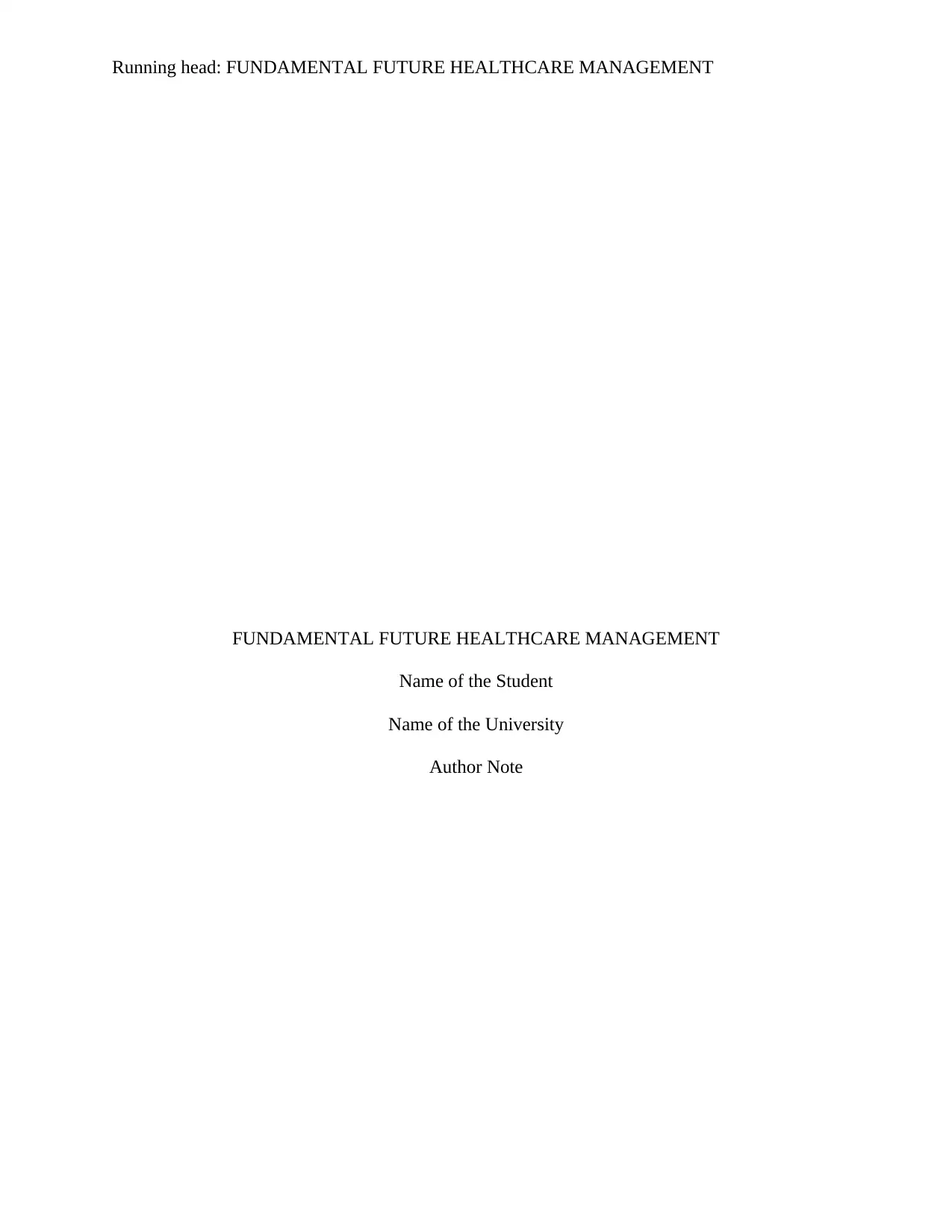
Running head: FUNDAMENTAL FUTURE HEALTHCARE MANAGEMENT
FUNDAMENTAL FUTURE HEALTHCARE MANAGEMENT
Name of the Student
Name of the University
Author Note
FUNDAMENTAL FUTURE HEALTHCARE MANAGEMENT
Name of the Student
Name of the University
Author Note
Paraphrase This Document
Need a fresh take? Get an instant paraphrase of this document with our AI Paraphraser
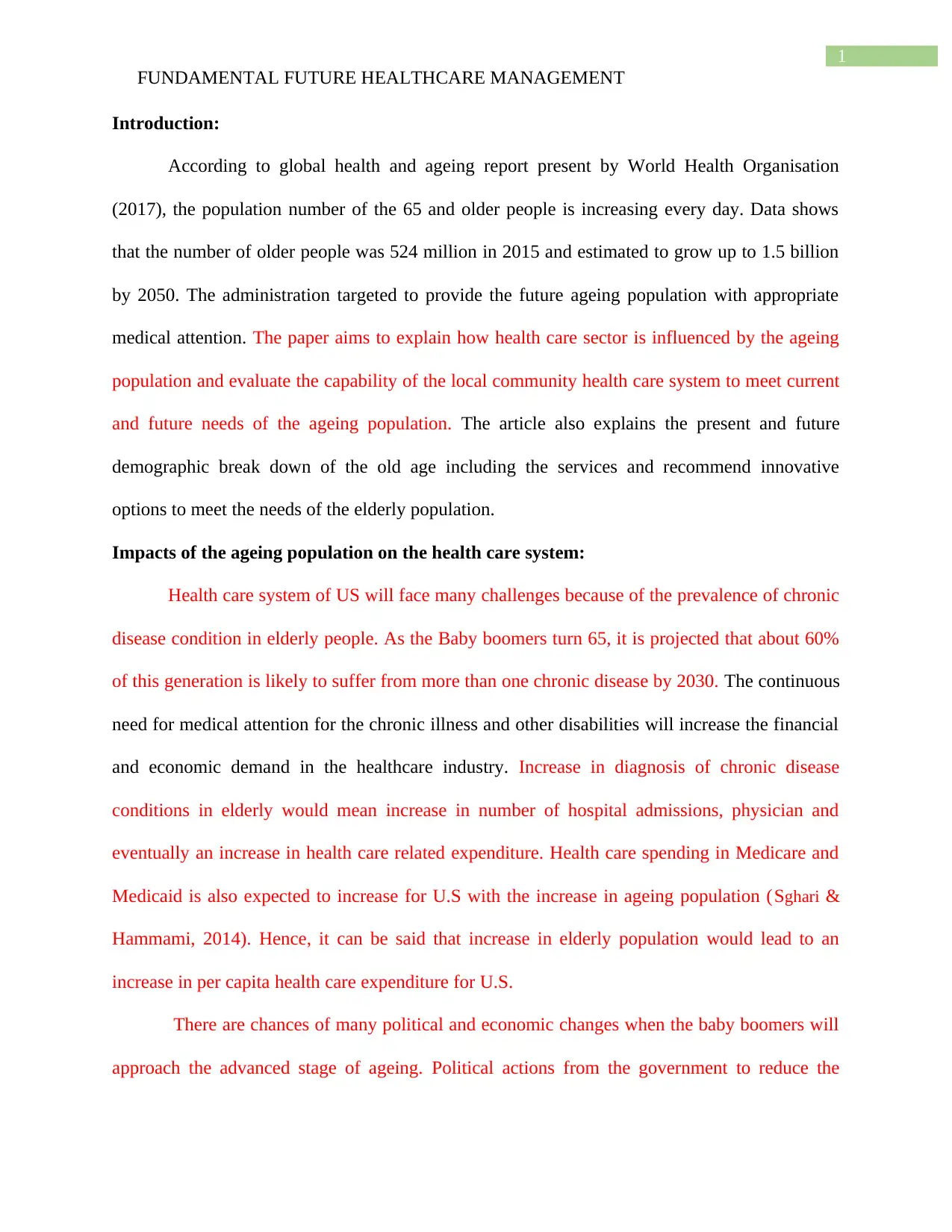
1
FUNDAMENTAL FUTURE HEALTHCARE MANAGEMENT
Introduction:
According to global health and ageing report present by World Health Organisation
(2017), the population number of the 65 and older people is increasing every day. Data shows
that the number of older people was 524 million in 2015 and estimated to grow up to 1.5 billion
by 2050. The administration targeted to provide the future ageing population with appropriate
medical attention. The paper aims to explain how health care sector is influenced by the ageing
population and evaluate the capability of the local community health care system to meet current
and future needs of the ageing population. The article also explains the present and future
demographic break down of the old age including the services and recommend innovative
options to meet the needs of the elderly population.
Impacts of the ageing population on the health care system:
Health care system of US will face many challenges because of the prevalence of chronic
disease condition in elderly people. As the Baby boomers turn 65, it is projected that about 60%
of this generation is likely to suffer from more than one chronic disease by 2030. The continuous
need for medical attention for the chronic illness and other disabilities will increase the financial
and economic demand in the healthcare industry. Increase in diagnosis of chronic disease
conditions in elderly would mean increase in number of hospital admissions, physician and
eventually an increase in health care related expenditure. Health care spending in Medicare and
Medicaid is also expected to increase for U.S with the increase in ageing population (Sghari &
Hammami, 2014). Hence, it can be said that increase in elderly population would lead to an
increase in per capita health care expenditure for U.S.
There are chances of many political and economic changes when the baby boomers will
approach the advanced stage of ageing. Political actions from the government to reduce the
FUNDAMENTAL FUTURE HEALTHCARE MANAGEMENT
Introduction:
According to global health and ageing report present by World Health Organisation
(2017), the population number of the 65 and older people is increasing every day. Data shows
that the number of older people was 524 million in 2015 and estimated to grow up to 1.5 billion
by 2050. The administration targeted to provide the future ageing population with appropriate
medical attention. The paper aims to explain how health care sector is influenced by the ageing
population and evaluate the capability of the local community health care system to meet current
and future needs of the ageing population. The article also explains the present and future
demographic break down of the old age including the services and recommend innovative
options to meet the needs of the elderly population.
Impacts of the ageing population on the health care system:
Health care system of US will face many challenges because of the prevalence of chronic
disease condition in elderly people. As the Baby boomers turn 65, it is projected that about 60%
of this generation is likely to suffer from more than one chronic disease by 2030. The continuous
need for medical attention for the chronic illness and other disabilities will increase the financial
and economic demand in the healthcare industry. Increase in diagnosis of chronic disease
conditions in elderly would mean increase in number of hospital admissions, physician and
eventually an increase in health care related expenditure. Health care spending in Medicare and
Medicaid is also expected to increase for U.S with the increase in ageing population (Sghari &
Hammami, 2014). Hence, it can be said that increase in elderly population would lead to an
increase in per capita health care expenditure for U.S.
There are chances of many political and economic changes when the baby boomers will
approach the advanced stage of ageing. Political actions from the government to reduce the
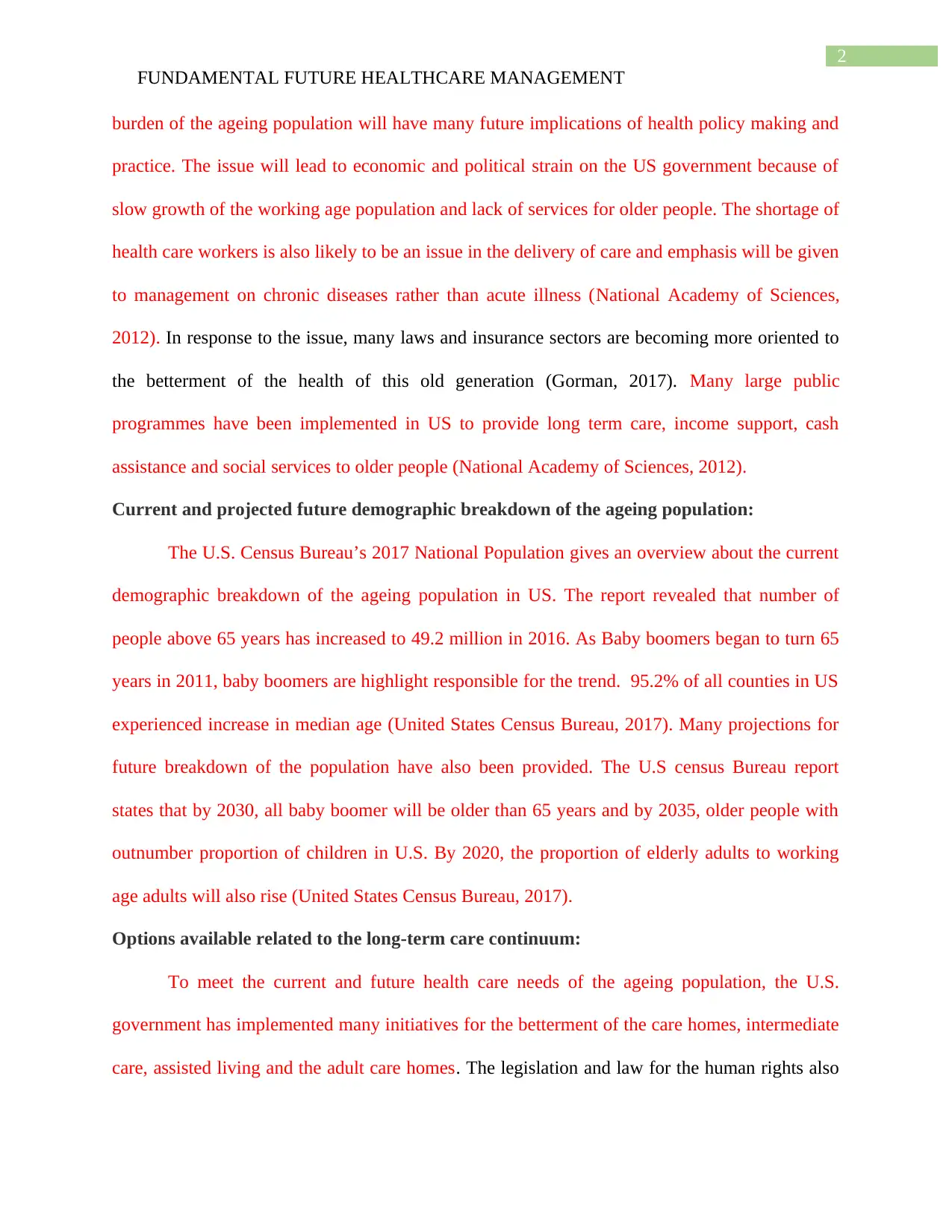
2
FUNDAMENTAL FUTURE HEALTHCARE MANAGEMENT
burden of the ageing population will have many future implications of health policy making and
practice. The issue will lead to economic and political strain on the US government because of
slow growth of the working age population and lack of services for older people. The shortage of
health care workers is also likely to be an issue in the delivery of care and emphasis will be given
to management on chronic diseases rather than acute illness (National Academy of Sciences,
2012). In response to the issue, many laws and insurance sectors are becoming more oriented to
the betterment of the health of this old generation (Gorman, 2017). Many large public
programmes have been implemented in US to provide long term care, income support, cash
assistance and social services to older people (National Academy of Sciences, 2012).
Current and projected future demographic breakdown of the ageing population:
The U.S. Census Bureau’s 2017 National Population gives an overview about the current
demographic breakdown of the ageing population in US. The report revealed that number of
people above 65 years has increased to 49.2 million in 2016. As Baby boomers began to turn 65
years in 2011, baby boomers are highlight responsible for the trend. 95.2% of all counties in US
experienced increase in median age (United States Census Bureau, 2017). Many projections for
future breakdown of the population have also been provided. The U.S census Bureau report
states that by 2030, all baby boomer will be older than 65 years and by 2035, older people with
outnumber proportion of children in U.S. By 2020, the proportion of elderly adults to working
age adults will also rise (United States Census Bureau, 2017).
Options available related to the long-term care continuum:
To meet the current and future health care needs of the ageing population, the U.S.
government has implemented many initiatives for the betterment of the care homes, intermediate
care, assisted living and the adult care homes. The legislation and law for the human rights also
FUNDAMENTAL FUTURE HEALTHCARE MANAGEMENT
burden of the ageing population will have many future implications of health policy making and
practice. The issue will lead to economic and political strain on the US government because of
slow growth of the working age population and lack of services for older people. The shortage of
health care workers is also likely to be an issue in the delivery of care and emphasis will be given
to management on chronic diseases rather than acute illness (National Academy of Sciences,
2012). In response to the issue, many laws and insurance sectors are becoming more oriented to
the betterment of the health of this old generation (Gorman, 2017). Many large public
programmes have been implemented in US to provide long term care, income support, cash
assistance and social services to older people (National Academy of Sciences, 2012).
Current and projected future demographic breakdown of the ageing population:
The U.S. Census Bureau’s 2017 National Population gives an overview about the current
demographic breakdown of the ageing population in US. The report revealed that number of
people above 65 years has increased to 49.2 million in 2016. As Baby boomers began to turn 65
years in 2011, baby boomers are highlight responsible for the trend. 95.2% of all counties in US
experienced increase in median age (United States Census Bureau, 2017). Many projections for
future breakdown of the population have also been provided. The U.S census Bureau report
states that by 2030, all baby boomer will be older than 65 years and by 2035, older people with
outnumber proportion of children in U.S. By 2020, the proportion of elderly adults to working
age adults will also rise (United States Census Bureau, 2017).
Options available related to the long-term care continuum:
To meet the current and future health care needs of the ageing population, the U.S.
government has implemented many initiatives for the betterment of the care homes, intermediate
care, assisted living and the adult care homes. The legislation and law for the human rights also
⊘ This is a preview!⊘
Do you want full access?
Subscribe today to unlock all pages.

Trusted by 1+ million students worldwide
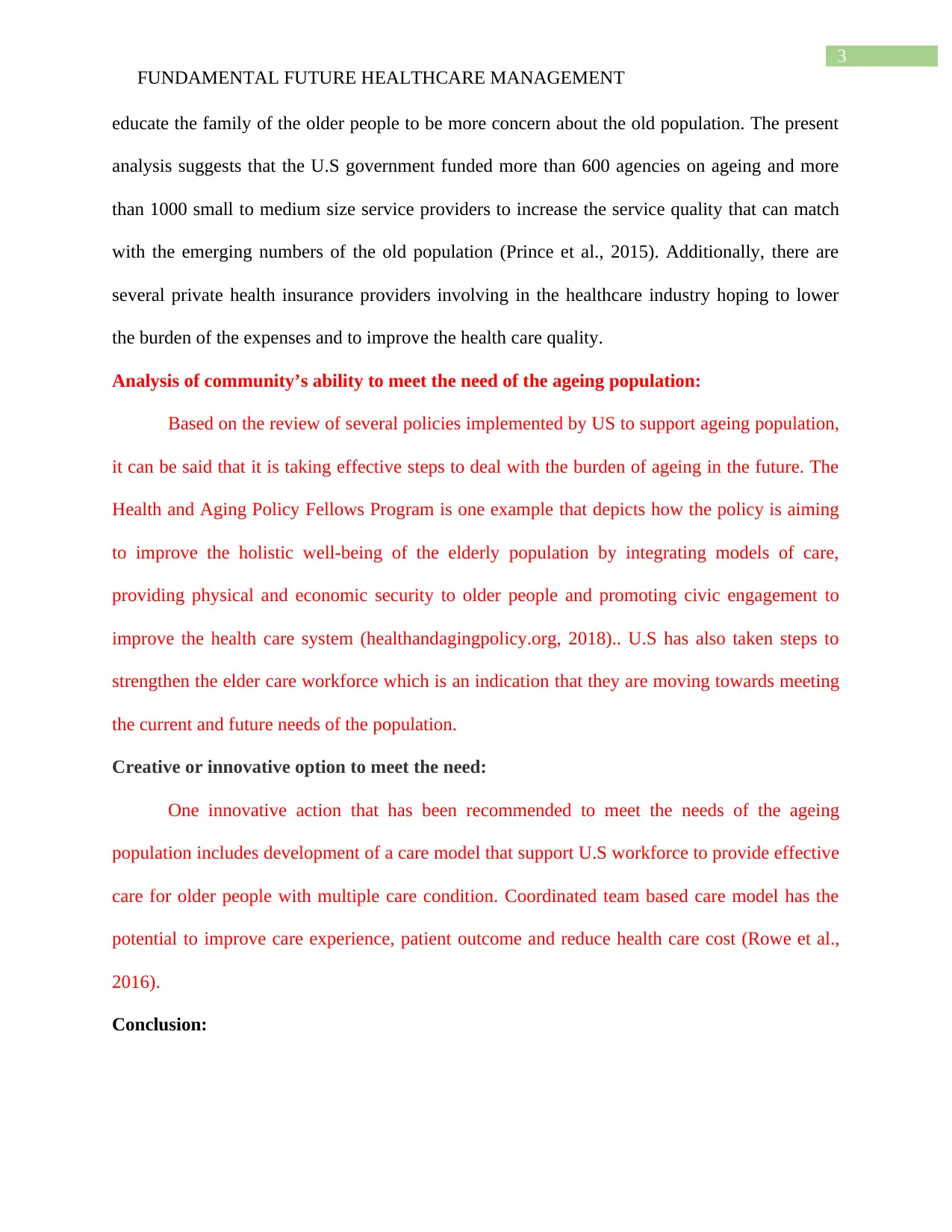
3
FUNDAMENTAL FUTURE HEALTHCARE MANAGEMENT
educate the family of the older people to be more concern about the old population. The present
analysis suggests that the U.S government funded more than 600 agencies on ageing and more
than 1000 small to medium size service providers to increase the service quality that can match
with the emerging numbers of the old population (Prince et al., 2015). Additionally, there are
several private health insurance providers involving in the healthcare industry hoping to lower
the burden of the expenses and to improve the health care quality.
Analysis of community’s ability to meet the need of the ageing population:
Based on the review of several policies implemented by US to support ageing population,
it can be said that it is taking effective steps to deal with the burden of ageing in the future. The
Health and Aging Policy Fellows Program is one example that depicts how the policy is aiming
to improve the holistic well-being of the elderly population by integrating models of care,
providing physical and economic security to older people and promoting civic engagement to
improve the health care system (healthandagingpolicy.org, 2018).. U.S has also taken steps to
strengthen the elder care workforce which is an indication that they are moving towards meeting
the current and future needs of the population.
Creative or innovative option to meet the need:
One innovative action that has been recommended to meet the needs of the ageing
population includes development of a care model that support U.S workforce to provide effective
care for older people with multiple care condition. Coordinated team based care model has the
potential to improve care experience, patient outcome and reduce health care cost (Rowe et al.,
2016).
Conclusion:
FUNDAMENTAL FUTURE HEALTHCARE MANAGEMENT
educate the family of the older people to be more concern about the old population. The present
analysis suggests that the U.S government funded more than 600 agencies on ageing and more
than 1000 small to medium size service providers to increase the service quality that can match
with the emerging numbers of the old population (Prince et al., 2015). Additionally, there are
several private health insurance providers involving in the healthcare industry hoping to lower
the burden of the expenses and to improve the health care quality.
Analysis of community’s ability to meet the need of the ageing population:
Based on the review of several policies implemented by US to support ageing population,
it can be said that it is taking effective steps to deal with the burden of ageing in the future. The
Health and Aging Policy Fellows Program is one example that depicts how the policy is aiming
to improve the holistic well-being of the elderly population by integrating models of care,
providing physical and economic security to older people and promoting civic engagement to
improve the health care system (healthandagingpolicy.org, 2018).. U.S has also taken steps to
strengthen the elder care workforce which is an indication that they are moving towards meeting
the current and future needs of the population.
Creative or innovative option to meet the need:
One innovative action that has been recommended to meet the needs of the ageing
population includes development of a care model that support U.S workforce to provide effective
care for older people with multiple care condition. Coordinated team based care model has the
potential to improve care experience, patient outcome and reduce health care cost (Rowe et al.,
2016).
Conclusion:
Paraphrase This Document
Need a fresh take? Get an instant paraphrase of this document with our AI Paraphraser
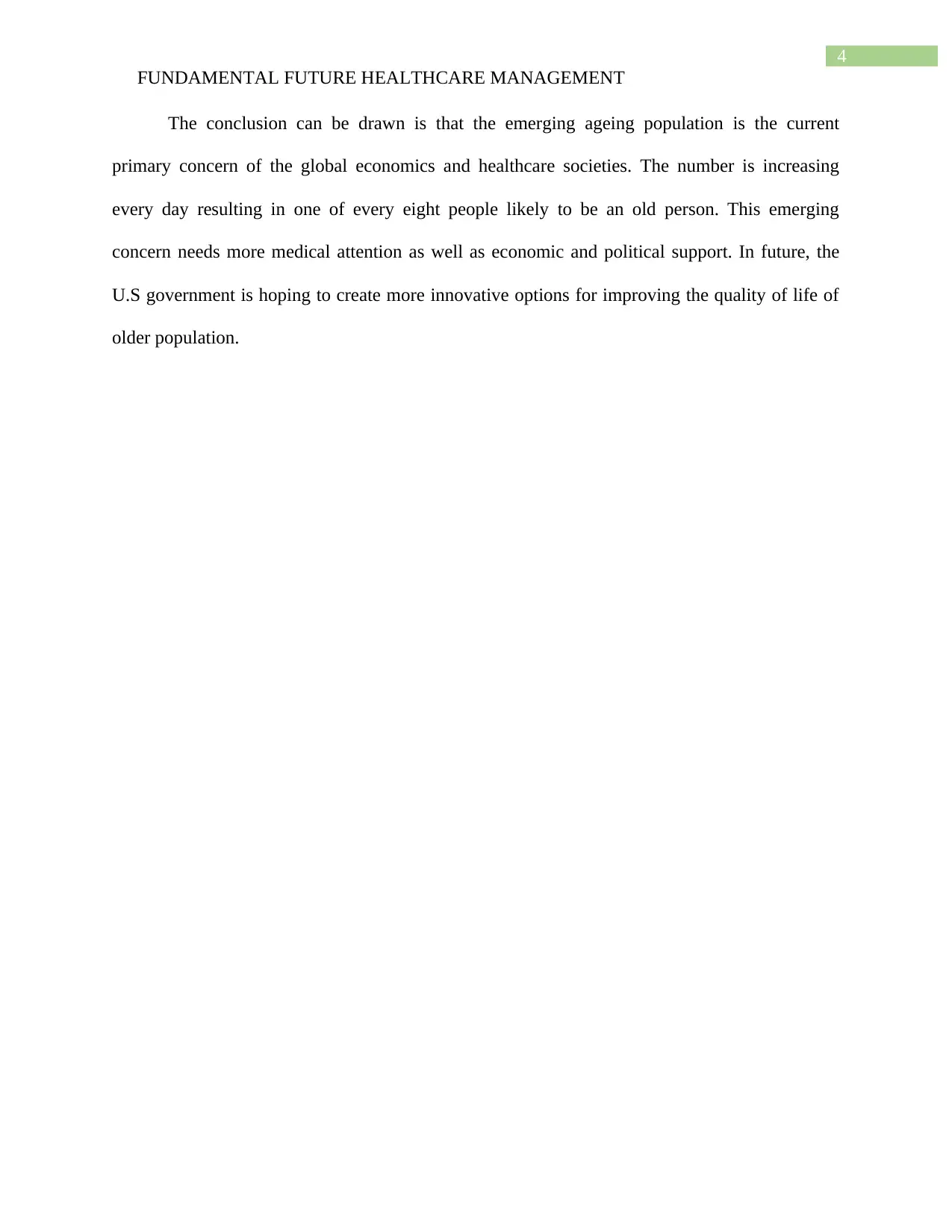
4
FUNDAMENTAL FUTURE HEALTHCARE MANAGEMENT
The conclusion can be drawn is that the emerging ageing population is the current
primary concern of the global economics and healthcare societies. The number is increasing
every day resulting in one of every eight people likely to be an old person. This emerging
concern needs more medical attention as well as economic and political support. In future, the
U.S government is hoping to create more innovative options for improving the quality of life of
older population.
FUNDAMENTAL FUTURE HEALTHCARE MANAGEMENT
The conclusion can be drawn is that the emerging ageing population is the current
primary concern of the global economics and healthcare societies. The number is increasing
every day resulting in one of every eight people likely to be an old person. This emerging
concern needs more medical attention as well as economic and political support. In future, the
U.S government is hoping to create more innovative options for improving the quality of life of
older population.
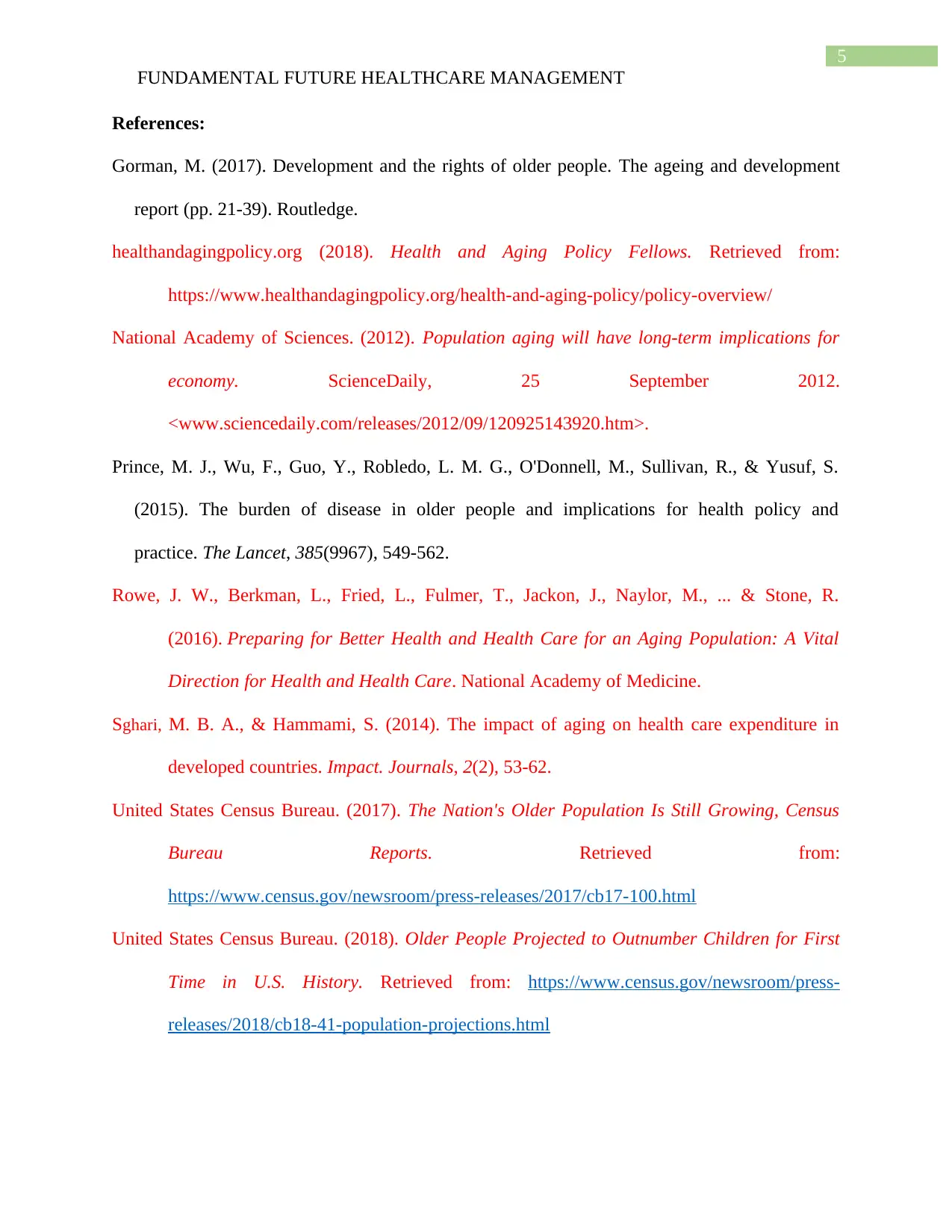
5
FUNDAMENTAL FUTURE HEALTHCARE MANAGEMENT
References:
Gorman, M. (2017). Development and the rights of older people. The ageing and development
report (pp. 21-39). Routledge.
healthandagingpolicy.org (2018). Health and Aging Policy Fellows. Retrieved from:
https://www.healthandagingpolicy.org/health-and-aging-policy/policy-overview/
National Academy of Sciences. (2012). Population aging will have long-term implications for
economy. ScienceDaily, 25 September 2012.
<www.sciencedaily.com/releases/2012/09/120925143920.htm>.
Prince, M. J., Wu, F., Guo, Y., Robledo, L. M. G., O'Donnell, M., Sullivan, R., & Yusuf, S.
(2015). The burden of disease in older people and implications for health policy and
practice. The Lancet, 385(9967), 549-562.
Rowe, J. W., Berkman, L., Fried, L., Fulmer, T., Jackon, J., Naylor, M., ... & Stone, R.
(2016). Preparing for Better Health and Health Care for an Aging Population: A Vital
Direction for Health and Health Care. National Academy of Medicine.
Sghari, M. B. A., & Hammami, S. (2014). The impact of aging on health care expenditure in
developed countries. Impact. Journals, 2(2), 53-62.
United States Census Bureau. (2017). The Nation's Older Population Is Still Growing, Census
Bureau Reports. Retrieved from:
https://www.census.gov/newsroom/press-releases/2017/cb17-100.html
United States Census Bureau. (2018). Older People Projected to Outnumber Children for First
Time in U.S. History. Retrieved from: https://www.census.gov/newsroom/press-
releases/2018/cb18-41-population-projections.html
FUNDAMENTAL FUTURE HEALTHCARE MANAGEMENT
References:
Gorman, M. (2017). Development and the rights of older people. The ageing and development
report (pp. 21-39). Routledge.
healthandagingpolicy.org (2018). Health and Aging Policy Fellows. Retrieved from:
https://www.healthandagingpolicy.org/health-and-aging-policy/policy-overview/
National Academy of Sciences. (2012). Population aging will have long-term implications for
economy. ScienceDaily, 25 September 2012.
<www.sciencedaily.com/releases/2012/09/120925143920.htm>.
Prince, M. J., Wu, F., Guo, Y., Robledo, L. M. G., O'Donnell, M., Sullivan, R., & Yusuf, S.
(2015). The burden of disease in older people and implications for health policy and
practice. The Lancet, 385(9967), 549-562.
Rowe, J. W., Berkman, L., Fried, L., Fulmer, T., Jackon, J., Naylor, M., ... & Stone, R.
(2016). Preparing for Better Health and Health Care for an Aging Population: A Vital
Direction for Health and Health Care. National Academy of Medicine.
Sghari, M. B. A., & Hammami, S. (2014). The impact of aging on health care expenditure in
developed countries. Impact. Journals, 2(2), 53-62.
United States Census Bureau. (2017). The Nation's Older Population Is Still Growing, Census
Bureau Reports. Retrieved from:
https://www.census.gov/newsroom/press-releases/2017/cb17-100.html
United States Census Bureau. (2018). Older People Projected to Outnumber Children for First
Time in U.S. History. Retrieved from: https://www.census.gov/newsroom/press-
releases/2018/cb18-41-population-projections.html
⊘ This is a preview!⊘
Do you want full access?
Subscribe today to unlock all pages.

Trusted by 1+ million students worldwide
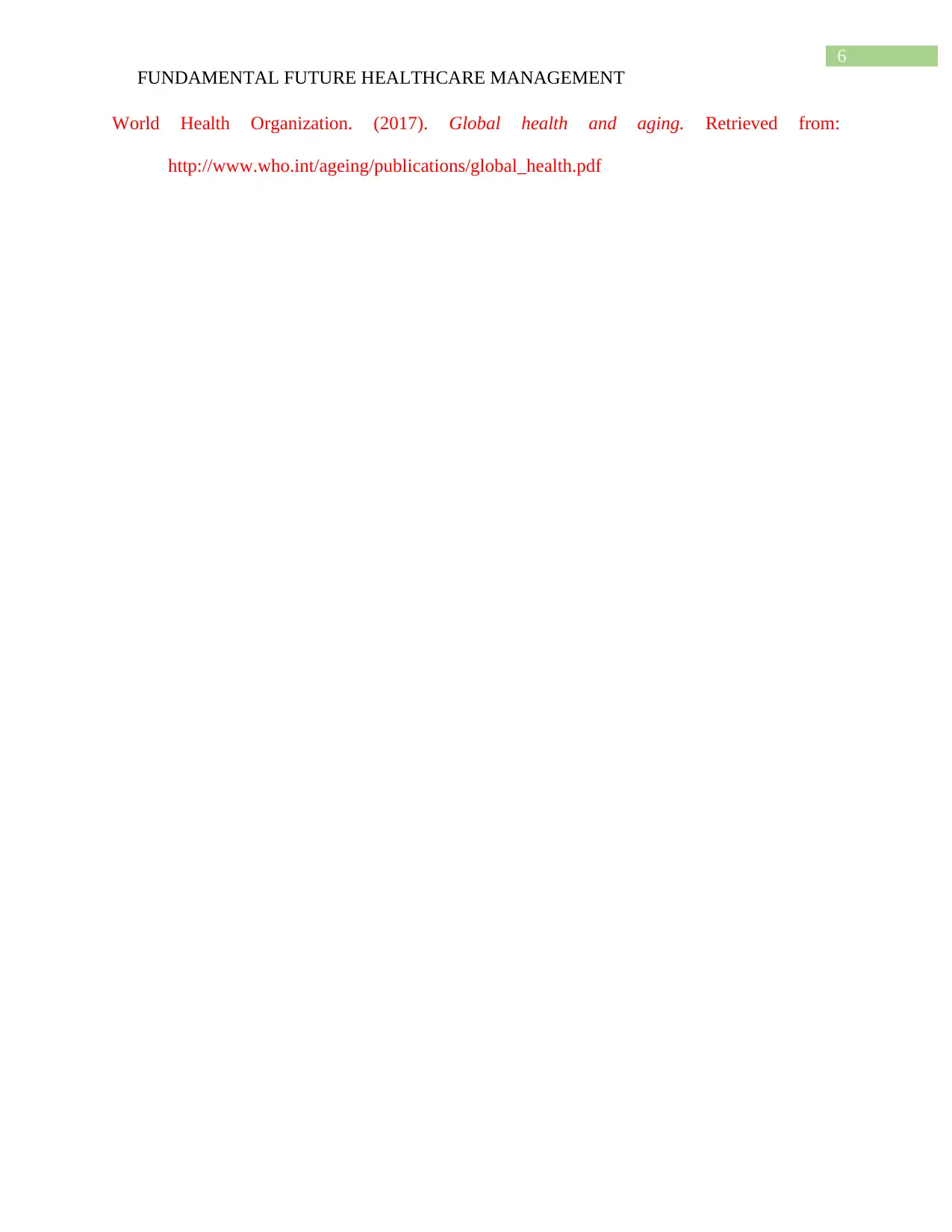
6
FUNDAMENTAL FUTURE HEALTHCARE MANAGEMENT
World Health Organization. (2017). Global health and aging. Retrieved from:
http://www.who.int/ageing/publications/global_health.pdf
FUNDAMENTAL FUTURE HEALTHCARE MANAGEMENT
World Health Organization. (2017). Global health and aging. Retrieved from:
http://www.who.int/ageing/publications/global_health.pdf
1 out of 7
Related Documents
Your All-in-One AI-Powered Toolkit for Academic Success.
+13062052269
info@desklib.com
Available 24*7 on WhatsApp / Email
![[object Object]](/_next/static/media/star-bottom.7253800d.svg)
Unlock your academic potential
Copyright © 2020–2025 A2Z Services. All Rights Reserved. Developed and managed by ZUCOL.





